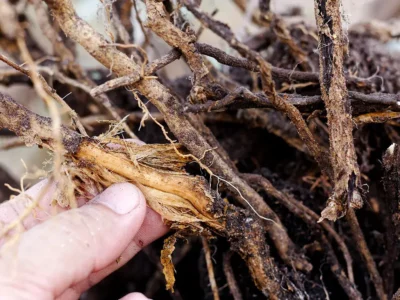With ever increasing frequency, the Heritage Tree Care Consulting Arborists are being called upon to investigate and manage trees suspected of being infected by the Phellinus noxious fungus. This fungus, which is a natural component of rainforest environments, is a brown root rot which causes decay, ultimately cutting off the trees water and nutrient supply resulting in the death of the host tree.
This tree pathogen is becoming an increasing problem in urban and amenity gardens as it results in an increased potential for tree failure in environments where risk mitigation forms an integral part of the tree management process.
The fungus is spread by root to root contact and potentially with airborne spores produced by the fruiting bodies. These fruiting bodies may present as a characteristic stocking on the roots and trunks, with a white margin when actively growing, turning cinnamon-brown with age. The resupinate form is smooth and flat and grows flush with the underside of logs and buttress roots. Not all infected trees display a stocking, and excavation of the root collar can sometimes be required to diagnose infected trees.
Stumps of infected trees can remain as a source of infection with the disease capable of remaining viable within the soil for up to 60 years. The mulch of infected trees can also spread the disease if not properly composted. As a result, new plantings within infected sites may rapidly die if the source of the infection is not removed.
Here are some interesting facts about this problematic pathogen:
- Known to affect over 200 species of tree from over 100 genera.
- Occurs along the east coast of Australia from Cape York to northern NSW.
- Is highly invasive and difficult to control.
- Wood becomes light, friable and honeycombed in the advanced stages of decay.
- In young trees wilting is followed by rapid death.
- In older trees progression can be slow, and trees may take many years to die.
Whilst this disease is difficult to control, there are some treatments that can be implemented to aid in the management of Phellinus noxious throughout the urban environment.
If removing infected trees, as many tree roots as possible should also be removed. This may require extensive excavations so is not always possible. The installation of tree root barriers may assist in isolating infected sites from surrounding areas and adjacent trees and vegetation.
Mulch from infected trees should be composted for a minimum of 16 weeks with regular turning and temperatures reaching 75°C. Mulch should be sieved to remove material >18mm before using.
Whilst chemical control of the fungus has been shown to slow or stop the progression of the fungus under laboratory conditions, this is not considered to be a viable control method in the urban environment. The application of beneficial Trichoderma spp. has been shown to significantly limit the progression of the fungus in trees and kill the disease in infected soils.
Heritage Tree Care continue to assist our clients and other tree managers in relation to the control of Phellinus noxious so if you think this may be a problem for you contact our consultants for further advise or to arrange an inspection of your tree assets.


 Are you Ready for Storm Season this Year?
Are you Ready for Storm Season this Year?